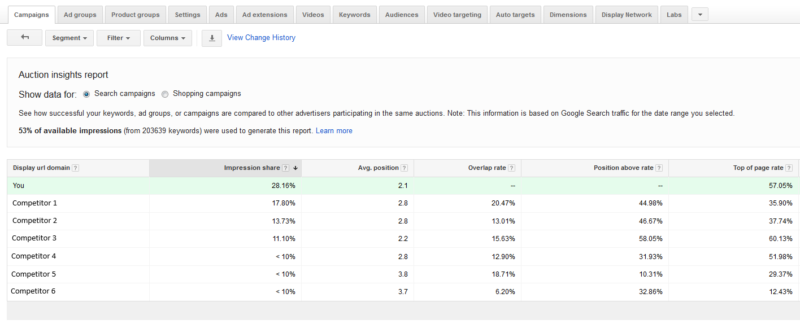What your paid search KPI says about you
Every advertiser measures success based on key performance indicators (KPIs) that they deem relevant. Columnist Andy Taylor asks, What do your chosen KPIs say about your priorities?
There are plenty of options for particular metrics to drive paid search programs toward, but not every KPI is created equal. Here, we’ll dive into what your preferred KPI says about you and provide recommendations to help you assess whether your KPI reflects the goals you care about.
All insights are at least slightly hyperbolic and assume you have a one-track mind for your KPI of choice. I bet some of you out there can keep two, three, maybe even more KPIs in mind when managing accounts, as you should. You’ll just have to meld the descriptions to uncover those deep insights into your psyche that you’re reading this to find.
Click-through rate
You waaaaaaant them to want you.
You neeeeeeed them to need you.
Some brands care a lot about how likely a user is to click on an ad, and for good reason. Click-through rate (CTR) is a key component of Quality Score, which Google uses to determine both how well an ad ranks and what price an advertiser must pay for clicks. Higher CTR means better rank and lower cost per click (CPC).
Thus, brands should make their ads as appealing as possible to searchers. However, chasing CTR above all else can lead to some poor choices.
Could I probably make a few friends at a college activity fair with this sign? Sure.
Will they still be my friends if I don’t actually have the goods? Probably not.
Similarly, advertisers might be able to draw more clicks with some versions of ad copy but end up hurting conversion rate or brand sentiment in the process. As such, it’s important to avoid pitfalls like overpromising or misleading searchers in the pursuit of higher CTR.
Impression share
You love to be seen, and ensuring your ads are present for a minimum share of relevant searches makes you feel good about your competitive position in search. Consistently getting in front of users searching for queries related to your business offerings is important, and that visibility can sometimes come at the cost of less flashy metrics like return on ad spend.
Advertisers can access estimates for the share of relevant impressions their ads are showing on the SERP by using Google Auction Insights reports. These reports also feature information on how often specific competitors are showing ads, as well as other metrics such as average position and top-of-page rate.
Shooting for impression share in search as your primary KPI isn’t that dissimilar from a television ad buy focused on reaching a specific segment of the television-watching population. Maybe in search you’re focused on getting in front of 100 percent of people searching for “red running shoes,” while on television you want to reach ESPN viewers in the 7:00–8:00 p.m. time block on the East Coast, with different categories of keywords somewhat analogous to different television channels in terms of audience differences.
The difference is that the effects of online interactions with ads are, for the most part, much easier to track than the effects of television ads. Users can be cookied, and online orders and other interactions such as email signups properly attributed to ad clicks. Thus, shooting exclusively for impression share requires abandoning this information in pursuit of visibility.
For many brands, performance metrics such as return on ad spend (ROAS) are deemed more meaningful in allocating search spend as effectively as possible. However, there are some advertisers who would prefer to lock up a percentage of impressions related to particular categories of search, regardless of how ROAS turns out.
Return on ad spend
Unimpressed by all the impressions and clicks your ads are getting, you’re solely interested in how much they cost and what your business gets out of them. Paid search is great for you, because it’s easy-peasy for most advertisers to track events such as orders and information inquiries to the clicks driving them.
The trickiness comes in how you measure that ROAS. Are you using last-click attribution? Accounting for offline interactions such as phone calls or store visits? Baking in the interactions that occur on a different device from the one searched on originally (cross-device)?
Not all ROAS measures are created equal, and the better an advertiser can get at attributing value to ads, the more effective optimization efforts will be. But since you care about performance so much, I bet you’ll put in the work to get attribution just right.
New customer acquisition
You’re all about growing your customer base, reaching those shoppers you’ve never been able to pull through other marketing channels. Maybe your business is such that paid search clicks from existing customers don’t carry much incremental value, or maybe you just really want to expand your market share.
There are a number of ways you can go about targeting those new customers. One is to shoot for cost per new customer acquisition as the primary KPI of search campaigns, while another strategy might involve trying to turn ads off to all existing customers via audience exclusions using Remarketing Lists for Search Ads (RLSA) and Customer Match audiences.
Choosing between these different methods of focusing on new customers should include evaluating what bringing back existing customers is worth. Is there literally no value to these interactions (very rare), or is it just that interactions with new customers should be valued more than those with existing customers (more common)?
Everyone likes new customers, but if you’re going to use new-to-file acquisition as a key measure of success, it’s best to make sure you’re not neglecting valuable existing clientele in search out of a desire for those shiny new shoppers.
Average position
I suppose what kind of person you are depends on what average position you want to be in. Want to stay in first? You’re a winner at heart who wants be number one. Really just hoping for position three? That’s a losing attitude right there.
Really though, shooting for average position in general is kind of a losing attitude. Sure, it might make sense to try to stay in position 1 for your own brand keywords, but shooting for a specific spot on the page with non-brand keywords regardless of cost and return on ad spend is pretty risky given the competitive nature of AdWords auctions. Get in a bidding war with a couple of competitors, and the ad spend can add up pretty quickly.
While there are some studies and individuals out there proclaiming that specific positions on the page magically perform better than others in metrics like conversion rate, most of the data and studies behind those conclusions can be politely characterized as pseudoscience. What’s more, even if those conclusions were true, they would change with every SERP update, such as the removal of text ads on the right rail and the addition of a fourth text ad above organic results rolled out in early 2016. As such, we recommend taking such declarations with a grain of salt.
Look at it all, focus on what’s important
The awesome part of paid search is that you can measure ALL of these metrics at the same time. The slight downside is that you have to choose what’s most important to your brand, which can be harder for some to pin down than others.
Paid search ads almost certainly have an impact on brand awareness and recall, though those effects can be hard to measure. Thus, it makes sense to take into account metrics like impression share to see how visible ads are for particular keywords.
At the same time, impressions don’t directly put money in the bank, and focusing on metrics like return on ad spend and cost per new customer acquisition can better ensure brands are getting enough out of their spend to justify the expense.
In the big scheme of things, brands should keep track of all of these metrics (as well as others, such as conversion rate, average order value and more) but optimize toward those that prove the real value of search.
Opinions expressed in this article are those of the guest author and not necessarily Search Engine Land. Staff authors are listed here.
Related stories
New on Search Engine Land


